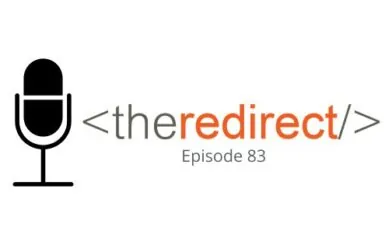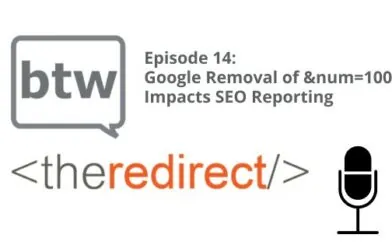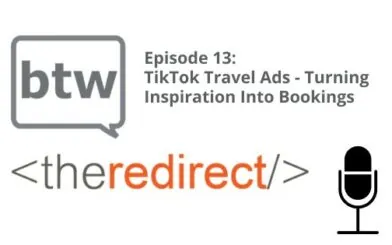Episode 55 / August 29, 2018
Listen now:
Welcome to The Redirect Podcast, where the BlackTruck team shares recent insights and takeaways from the world of search marketing.
In this week’s episode:
- An exploration into dark patterns, the user experience phenomenon commonly used to keep users in an app or on a site. But are there any impacts on search? (begins at 1:27).
- Many a time, the image that accompanies a featured snippet is not from the site that won the snippet. Nope, it’s from another site. We dive into understanding why and how those images get featured separately from the content, and what you can do about it (begins at 14:05).
- Plus, the episode wraps up with a plan for approaching landing pages purposely built for your PPC campaigns. Squeeze pages vs. landing pages, what you need to have on the page, and more (begins at 18:33).
Bad UX called “Dark Patterns”
We often talk about user privacy, disclosures, and have extensively covered GDPR. It’s not always so cut and dry around here in the States. As the EU works pretty tirelessly to keep users’ privacy safe, there are large misconceptions of how search works, how algorithms work, and how location and personal use history can impact your personal search results. To dig a little deeper into that, when was the last time you read past the first sentence of a user agreement? Lately we’ve been seeing them pop up a lot in footers or headers in site in a post-GDPR world telling us that “we use cookies, by closing this box, you are acknowledging acceptance blah blah.”
I (Patrick) follow a subreddit called “data is beautiful” and a post caught my eye. It was a 10-year chart for 3 search phrases compared: “How to delete Facebook,” “How to delete Twitter,” and “ How to delete Instagram.” This chart has been historically dominated by Facebook, but for the first time ever, Facebook has dropped, and “How to delete Instagram” has surpassed this search.
So when this data subreddit moves into a search-related theme, it caught my interest. In Episode 54, I spoke about how our phone/Google is still tracking us even if we turn off the timeline feature, and that the actual way to deactivate the tracking is buried in a setting.
Through this Reddit post, a comment linked to a YouTube video that discusses this “phenomenon,” and I learned that what I spoke about two weeks ago is called a “dark pattern,” and more specifically, this variation of a dark pattern is called “Roach Motel”: Easy to get into, almost impossible to get out. *cue Hotel California chorus*
Dark patterns create bad user experience (UX), but are so common and rampant that almost all the sites we visit on a daily basis practice this in one way or another. Be it roach motel, bait and switch, confirshaming (you sure you really don’t want to get smarter?), forced continuity, privacy zuckering, persuasive formatting, click tunneling, and several other concepts.
Do these dark patterns hurt your SEO? No, not really. Google won’t penalize you for using these methods. In fact, many of these practices can cause users to spend more time on your site, increase page depth, and result in your analytics or marketing goals being reached. On the flip side, if you create a consistently poor experience for your users over time, they may be less prone to engage with you online—or even start complaining about you.
At the end of the day, find a solution in UX that will satisfy your site owners and revenue goals, while not creating any negative sentiment for your users. You may not be a huge fish and you won’t have to worry about a bad PR experience, but nonetheless, if you keep it on the up and up, you won’t have to worry about falling victim to negative PR.
Featured Snippets with Image from Other Sites
What’s going on when your site is chosen for a featured snippet in Google, but the image in the snippet is from a different website? It’s not a fluke and in fact is quite intentional.
A recent SEM Post article shared some insight from Google’s John Mueller, summarized here:
“When Google does not choose the image from the featured snippet landing page, it often chooses the image that is ranking number one for the same query but in Google image search.” Remember, Google wants to give users the best results for their query, and that may mean serving your text result and a competitor’s image.
If this is happening in the featured snippets you’ve earned, it means your own images may be lacking.
Use the tips for image optimization we have discussed before, including an optimized file name and optimized alt tag. Other tips from The SEM Post’s Jennifer Slegg:
- Include multiple images on the page that are relevant to what you’re targeting; that way, you give Google some options to choose from for the snippet.
- Analyze the image that Google is currently showing in the featured snippet—both the image and its page of origin. Google chose that image for a reason, so let the image and the context it’s in help you learn how to make your own page and images better.
Work on improving the image(s) on your featured page, and you just might claim the featured snippet image eventually, too.
Landing Pages vs. Squeeze Pages for PPC
We’ve had a number of cases recently that have called for a custom landing pages for some of our clients, and for good reason. This presented a good opportunity to discuss what a landing page is vs. a squeeze page, and how to create an ideal landing page. Note, this is specifically in the context of landing pages for PPC campaigns.
What is a Squeeze Page?
A squeeze page can be defined as a page that you’re driving paid traffic to that has no additional—or very limited—internal navigational structure. These are often built on subdomains and through a third party service such as HubSpot, Unbounce, or Optimizely. What happens with a squeeze page is that I land on the page, and my options are to either convert or leave. As you can imagine, this results in a very high bounce rate.
The challenge with this structure is that user doesn’t get to experience the brand to its fullest extent. Typically, the more expensive or the more time-intensive the purchase is, the more thought and time goes into that purchase decision. If it’s a brand that I don’t know, and this is my first interaction, off of a paid search ad or display ad, a squeeze page might not be the best place to send me.
When Are Squeeze Pages OK to Use?
On the other hand, a squeeze page might work well for remarketing purposes or targeting people who are already in the mid-to-low stages of the funnel, because they are already familiar with the brand. I click on the ad, and now is an appropriate time for the brand to make the ask. I have already researched you to some extent and will be much more likely to convert.
Landing Pages
Why would you develop a landing page in the first place? It could be that your existing pages don’t align with the ad groups you’ve developed, or with the audience you’re trying to reach in terms of the language they’re using or their location, for example.
With landing pages, there is a unique opportunity to build a page within the existing site, using the existing design and navigation—not using a subdomain. If you operate a WordPress-based site, there’s no reason not to create the landing page as a page on your existing site. It especially makes sense if you’re dipping your toes in the water to learn about landing page optimization and don’t want to go deep into A/B testing. In that case, create the page, block it and make sure it’s not included in your sitemap, and use it specifically for PPC, display, or paid social traffic.
Often when landing pages are built on subdomains and are of the squeeze page variety, they may feel disjointed or unrecognizable as the brand. Building the page within your existing framework makes the “above the fold” experience consistent with your other digital messaging, visuals, etc. It also gives the visitor to opportunity to learn more about you if they’re not yet ready to convert.
Besides these design issues, if you’re using a landing page service, the pages may not load as quickly as your own site does. In that case, why not build it on your existing platform that you know will perform well?
If you can’t build the pages within your existing site, you might look into a landing page service such as Unbounce. You will need a subdomain to run these pages on, such as “marketing.blacktruckmedia.com,” and this is where you would send all paid traffic. This is especially recommended for bottom of the funnel lead generation.
Landing Page Quality Considerations
Jason shared loads of insights for creating a quality landing page in this episode. We’ll link up to a separate post with this info soon. In the meantime, you can listen starting at 22:33 to get all the details.
Bonus Pro Tip: You might not want to post about black hat SEO tactics on Reddit—Google’s always watching! Hat tip to Search Engine Roundtable for a good laugh.




